Презентация Wetland Plants Clarissa

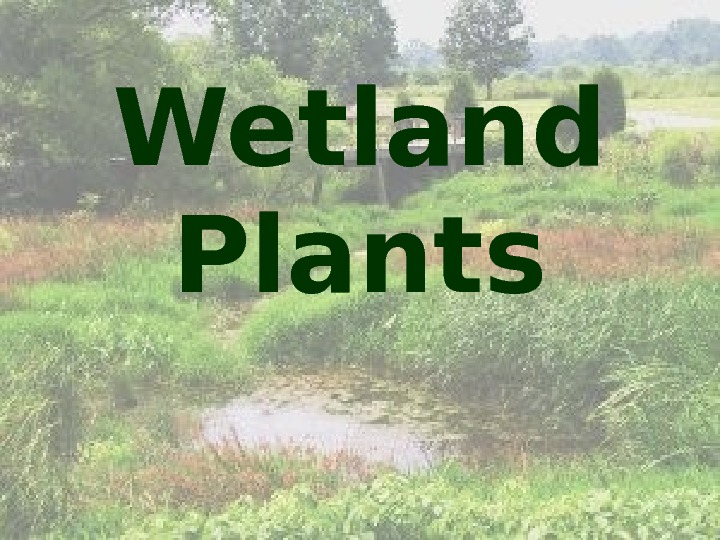
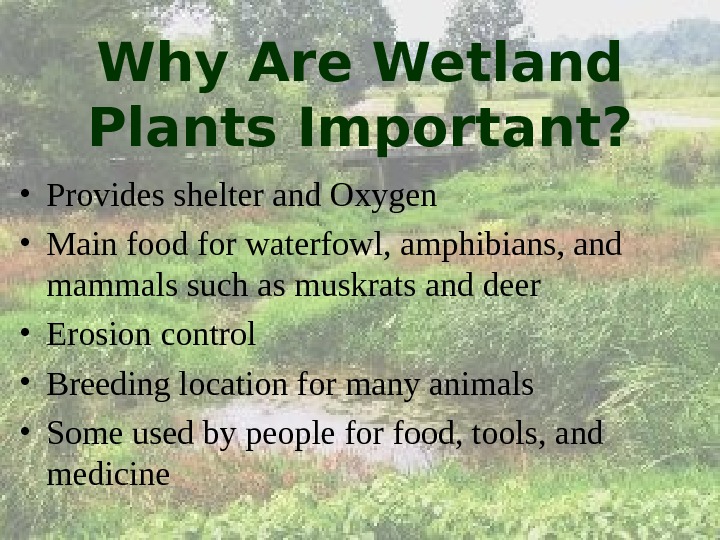
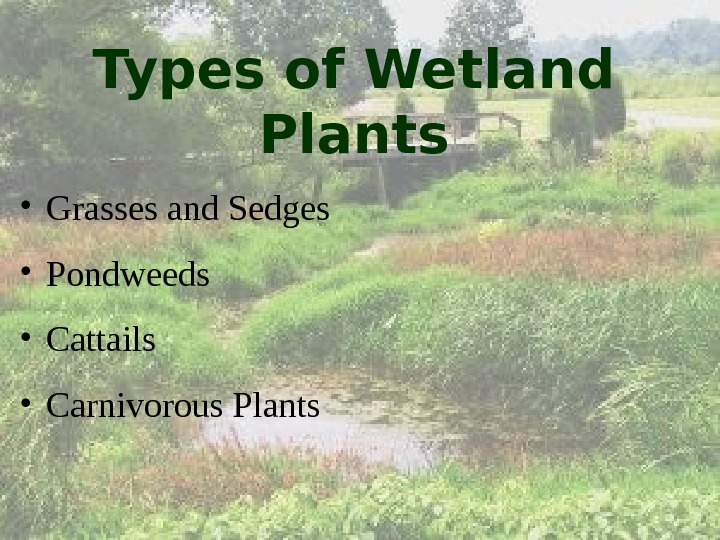
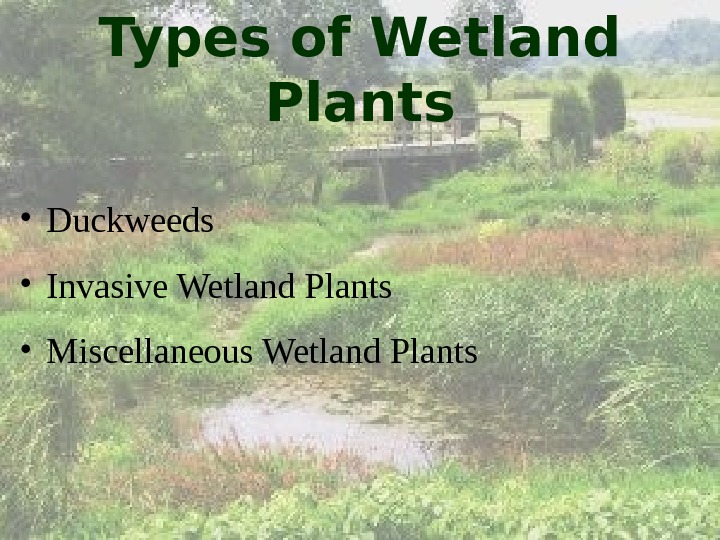
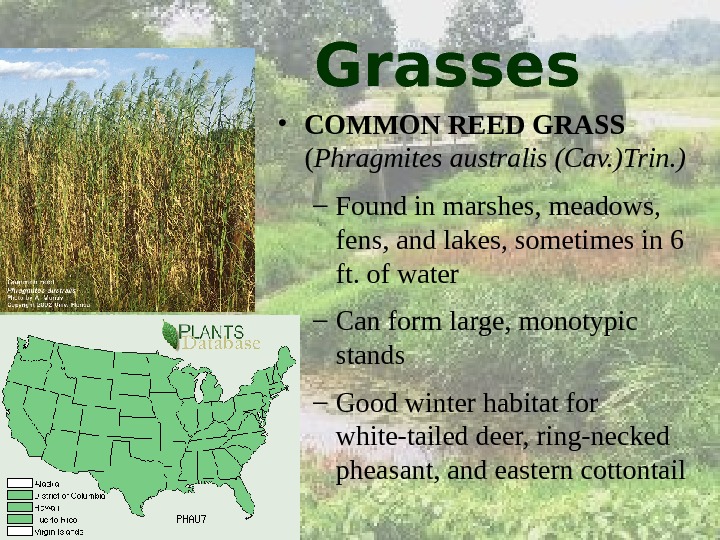
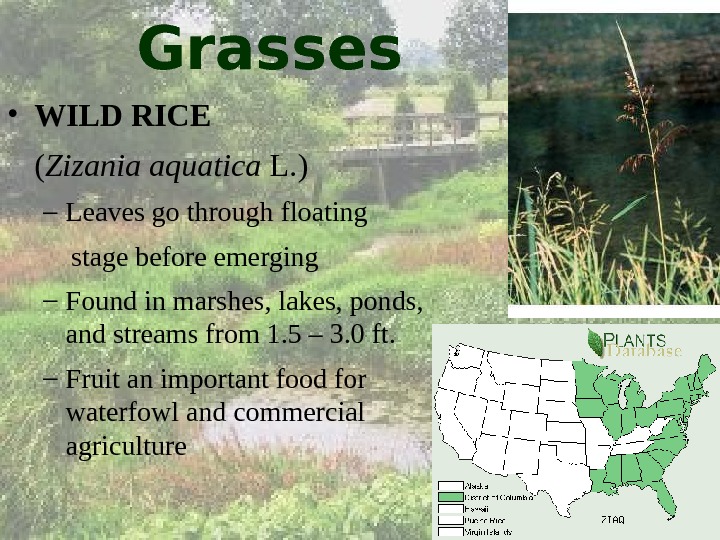
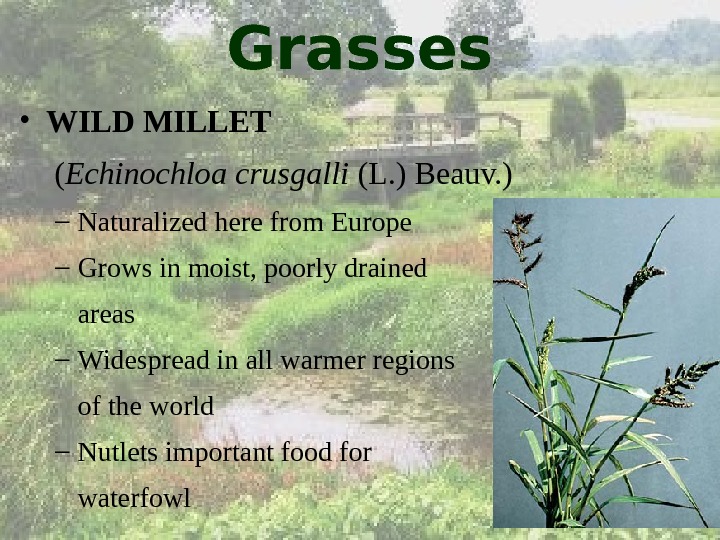

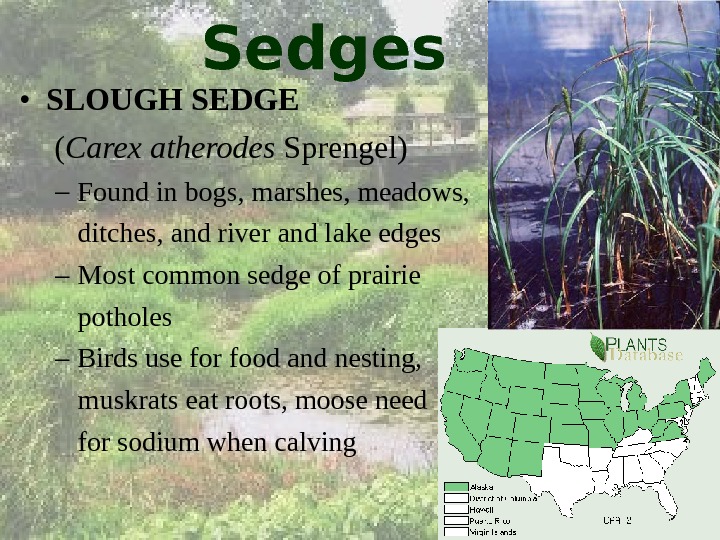
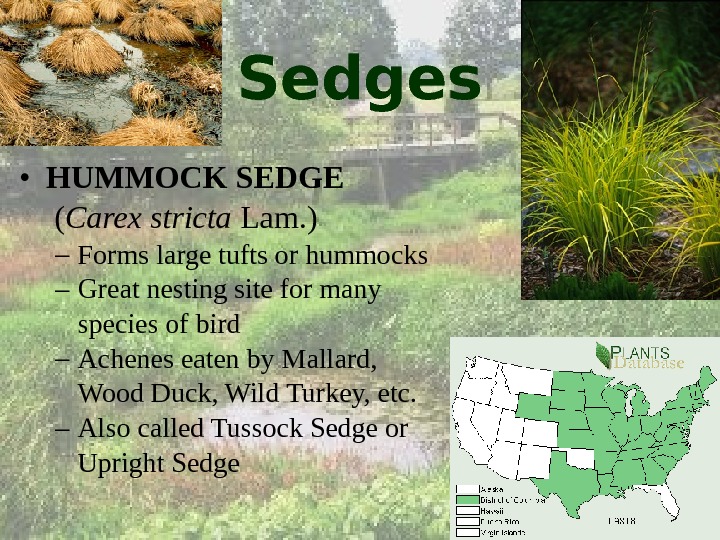
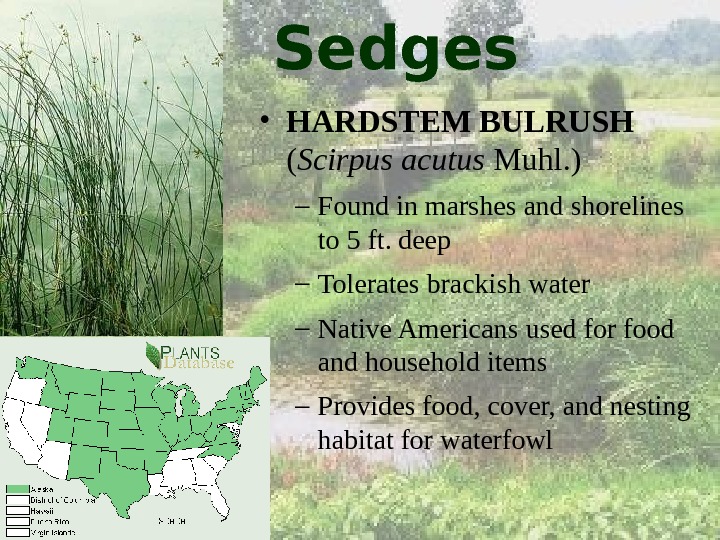

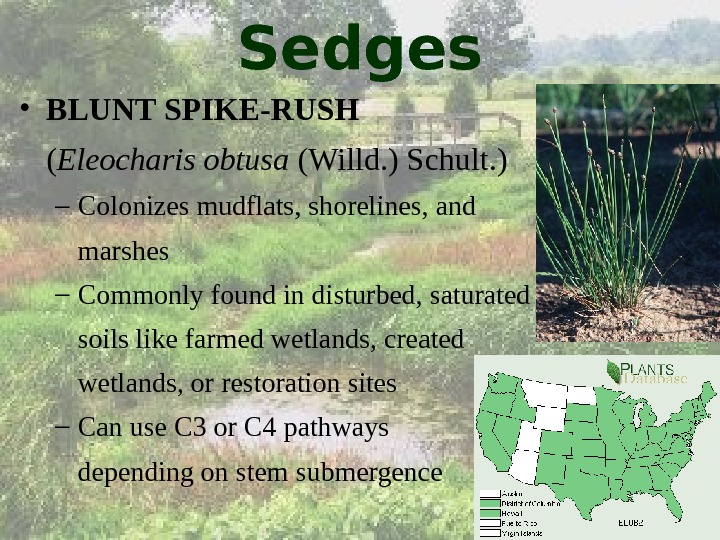
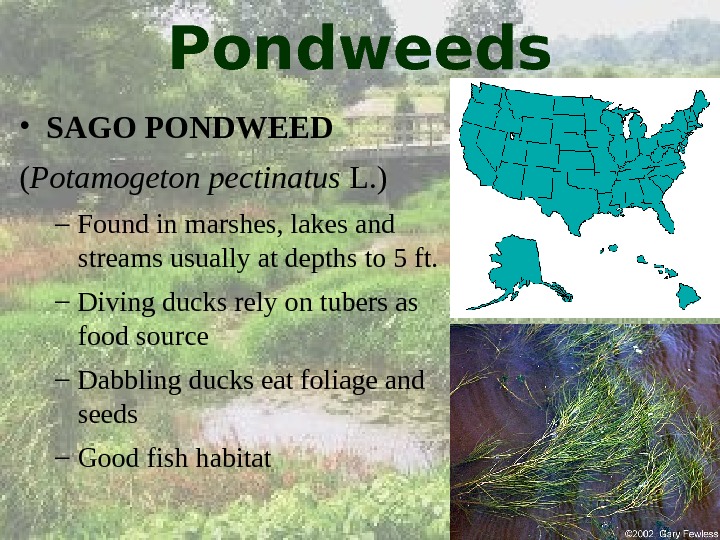
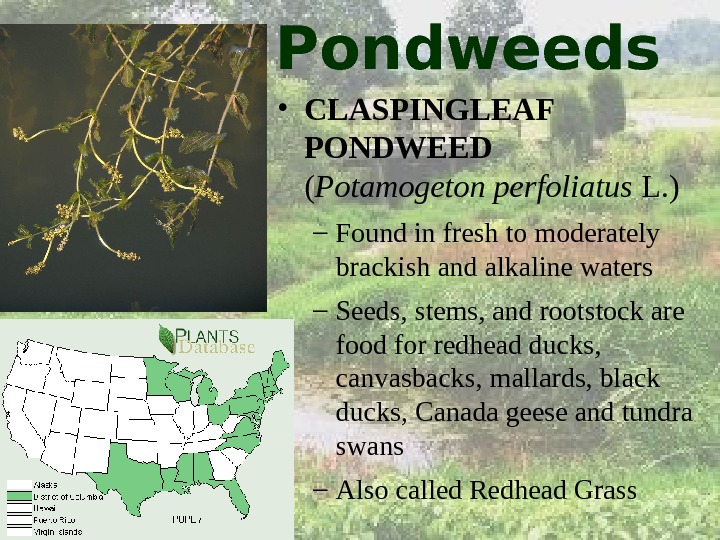
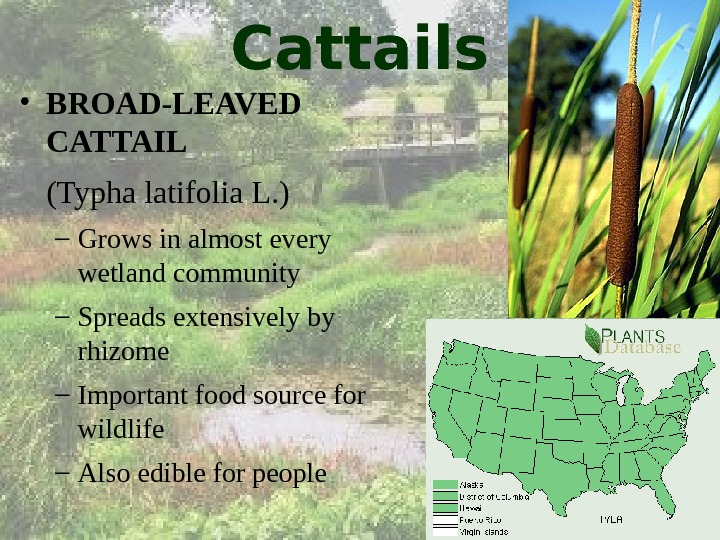
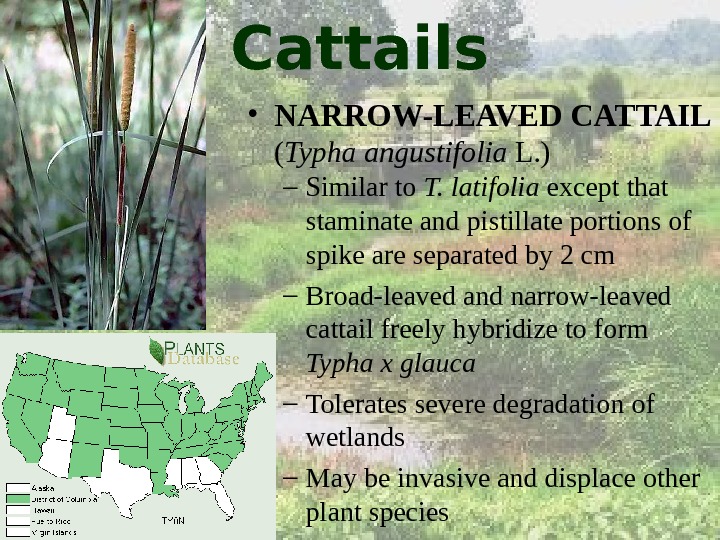
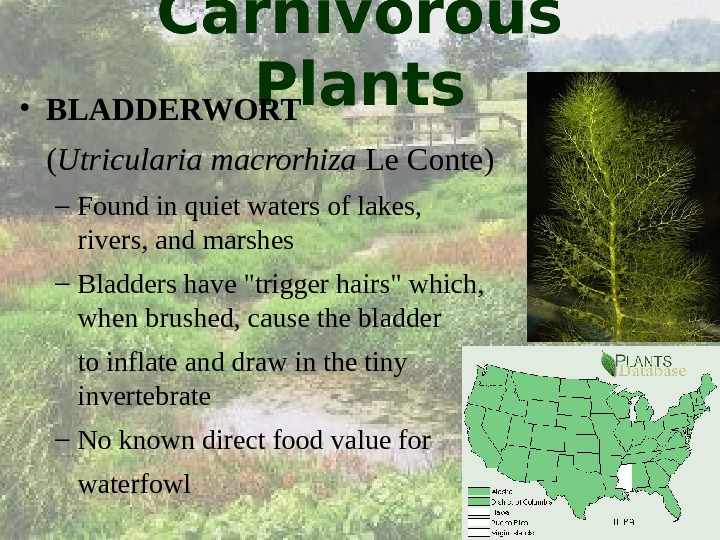
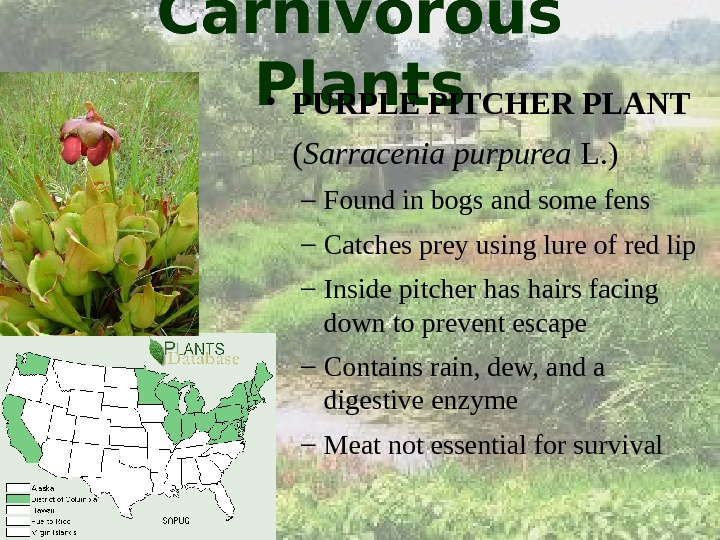

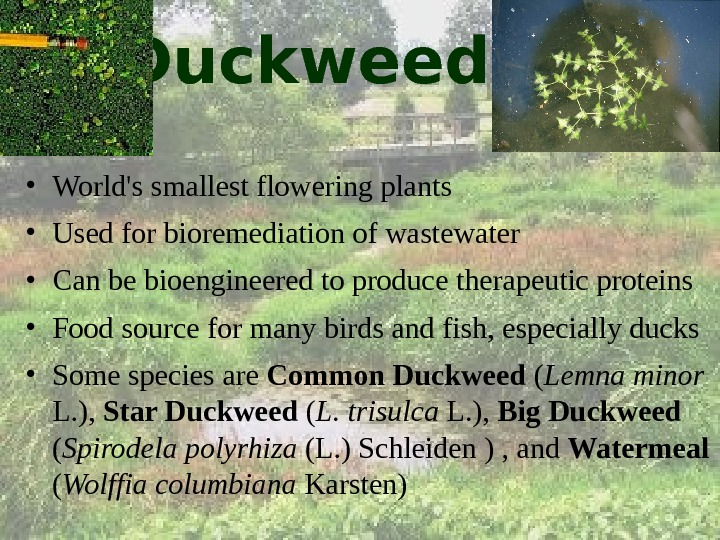

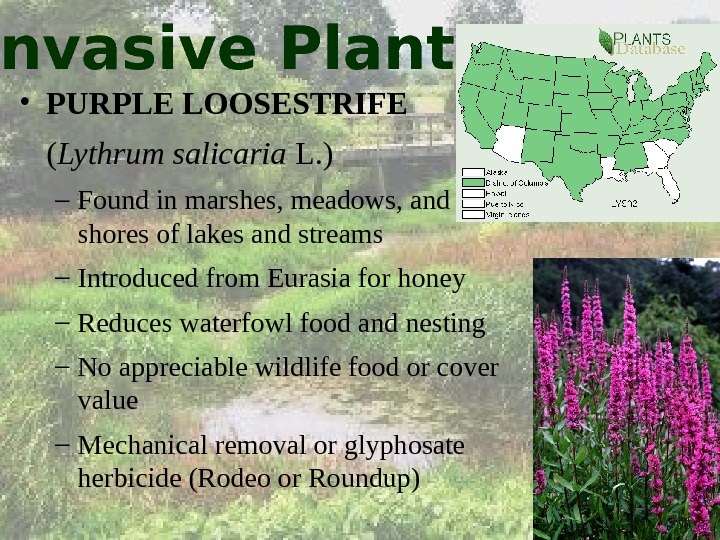

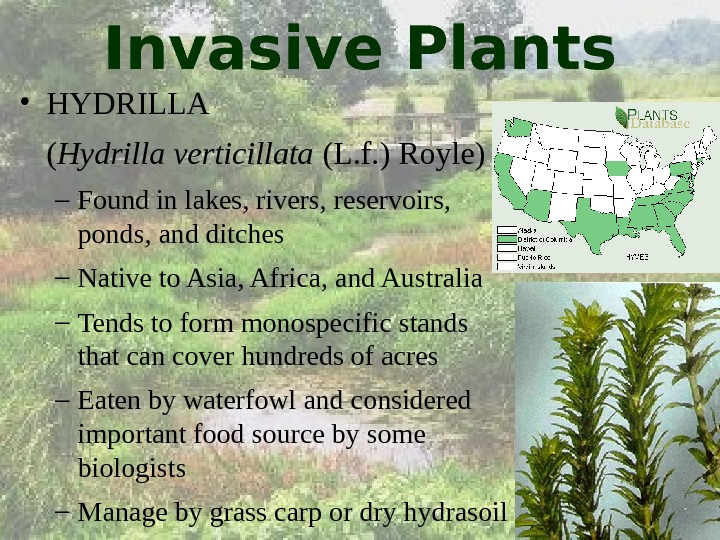
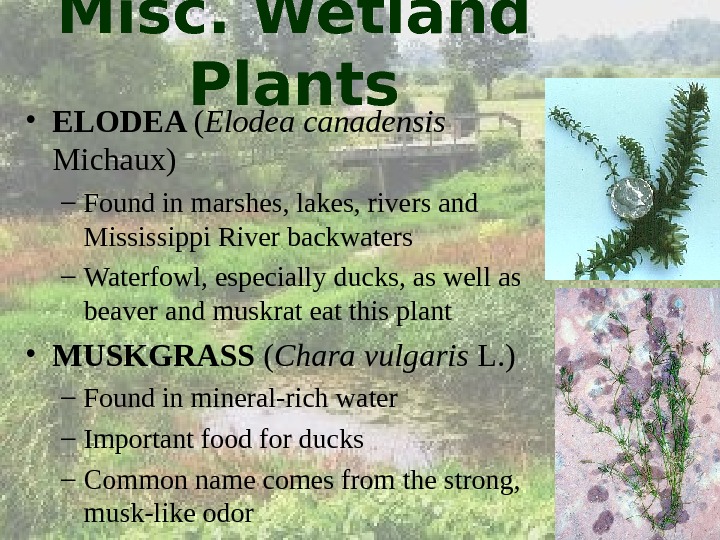
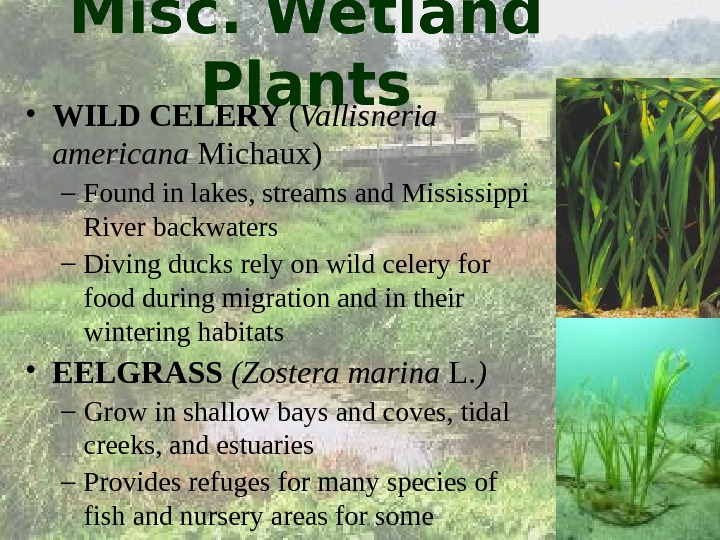
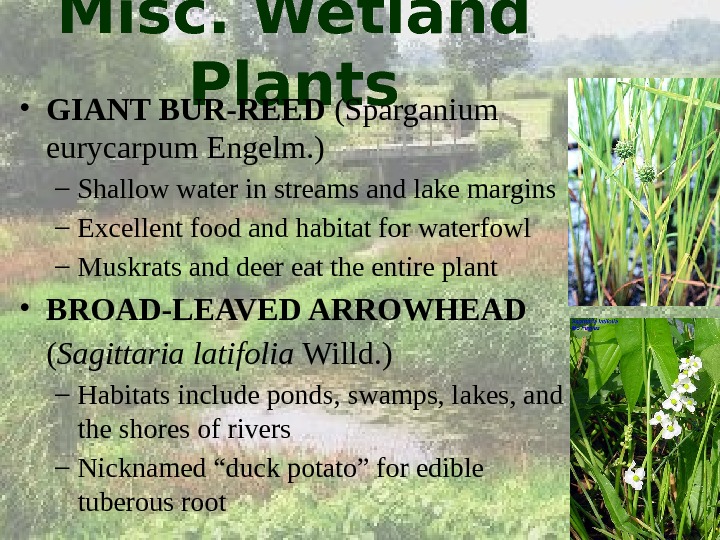
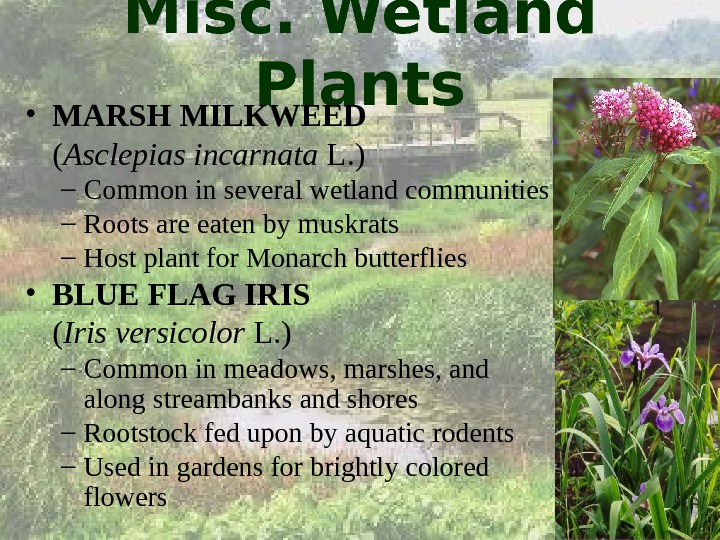
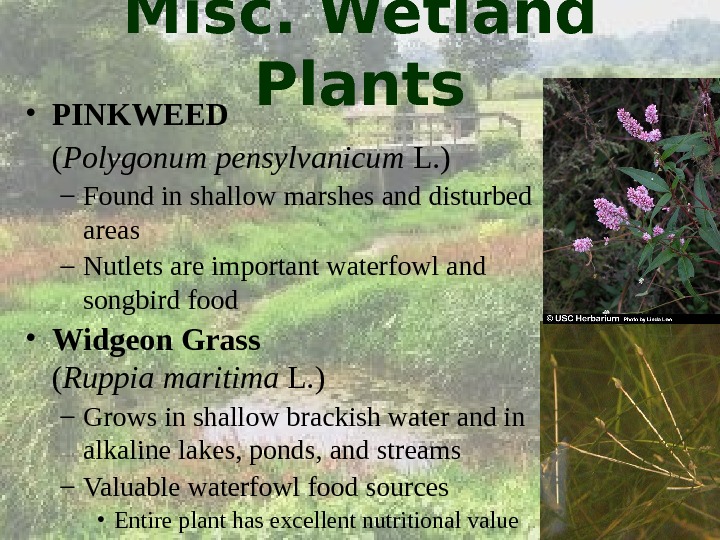
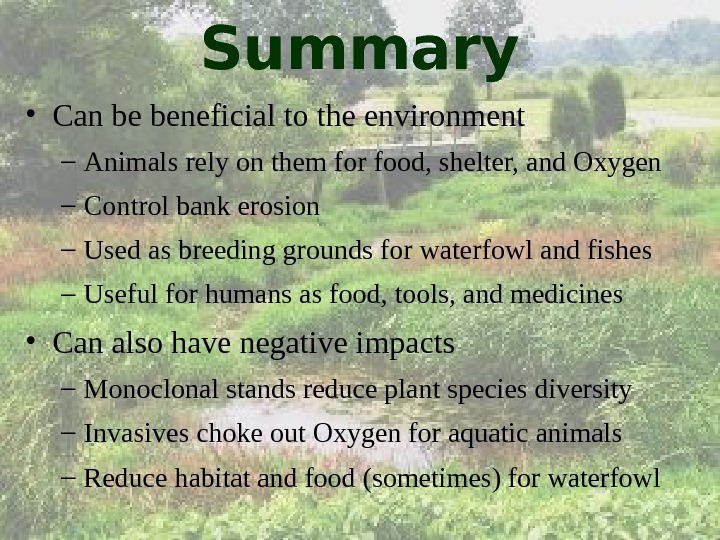
- Размер: 2.3 Mегабайта
- Количество слайдов: 31
Описание презентации Презентация Wetland Plants Clarissa по слайдам
 Wetland Plants
Wetland Plants
 Why Are Wetland Plants Important? • Provides shelter and Oxygen • Main food for waterfowl, amphibians, and mammals such as muskrats and deer • Erosion control • Breeding location for many animals • Some used by people for food, tools, and medicine
Why Are Wetland Plants Important? • Provides shelter and Oxygen • Main food for waterfowl, amphibians, and mammals such as muskrats and deer • Erosion control • Breeding location for many animals • Some used by people for food, tools, and medicine
 Types of Wetland Plants • Grasses and Sedges • Pondweeds • Cattails • Carnivorous Plants
Types of Wetland Plants • Grasses and Sedges • Pondweeds • Cattails • Carnivorous Plants
 Types of Wetland Plants • Duckweeds • Invasive Wetland Plants • Miscellaneous Wetland Plants
Types of Wetland Plants • Duckweeds • Invasive Wetland Plants • Miscellaneous Wetland Plants
 Grasses • COMMON REED GRASS ( Phragmites australis (Cav. )Trin. ) – Found in marshes, meadows, fens, and lakes, sometimes in 6 ft. of water – Can form large, monotypic stands – Good winter habitat for white-tailed deer, ring-necked pheasant, and eastern cottontail
Grasses • COMMON REED GRASS ( Phragmites australis (Cav. )Trin. ) – Found in marshes, meadows, fens, and lakes, sometimes in 6 ft. of water – Can form large, monotypic stands – Good winter habitat for white-tailed deer, ring-necked pheasant, and eastern cottontail
 Grasses • WILD RICE ( Zizania aquatica L. ) – Leaves go through floating stage before emerging – Found in marshes, lakes, ponds, and streams from 1. 5 – 3. 0 ft. – Fruit an important food for waterfowl and commercial agriculture
Grasses • WILD RICE ( Zizania aquatica L. ) – Leaves go through floating stage before emerging – Found in marshes, lakes, ponds, and streams from 1. 5 – 3. 0 ft. – Fruit an important food for waterfowl and commercial agriculture
 Grasses • WILD MILLET ( Echinochloa crusgalli (L. ) Beauv. ) – Naturalized here from Europe – Grows in moist, poorly drained areas – Widespread in all warmer regions of the world – Nutlets important food for waterfowl
Grasses • WILD MILLET ( Echinochloa crusgalli (L. ) Beauv. ) – Naturalized here from Europe – Grows in moist, poorly drained areas – Widespread in all warmer regions of the world – Nutlets important food for waterfowl
 Sedges • LAKE SEDGE ( Carex lacustris Willd. ) – Common and found in shallow water of swamps, marshes, lakes, and streams – Forms scattered clones or beds – Achenes eaten by waterfowl
Sedges • LAKE SEDGE ( Carex lacustris Willd. ) – Common and found in shallow water of swamps, marshes, lakes, and streams – Forms scattered clones or beds – Achenes eaten by waterfowl
 Sedges • SLOUGH SEDGE ( Carex atherodes Sprengel) – Found in bogs, marshes, meadows, ditches, and river and lake edges – Most common sedge of prairie potholes – Birds use for food and nesting, muskrats eat roots, moose need for sodium when calving
Sedges • SLOUGH SEDGE ( Carex atherodes Sprengel) – Found in bogs, marshes, meadows, ditches, and river and lake edges – Most common sedge of prairie potholes – Birds use for food and nesting, muskrats eat roots, moose need for sodium when calving
 Sedges • HUMMOCK SEDGE ( Carex stricta Lam. ) – Forms large tufts or hummocks – Great nesting site for many species of bird – Achenes eaten by Mallard, Wood Duck, Wild Turkey, etc. – Also called Tussock Sedge or Upright Sedge
Sedges • HUMMOCK SEDGE ( Carex stricta Lam. ) – Forms large tufts or hummocks – Great nesting site for many species of bird – Achenes eaten by Mallard, Wood Duck, Wild Turkey, etc. – Also called Tussock Sedge or Upright Sedge
 Sedges • HARDSTEM BULRUSH ( Scirpus acutus Muhl. ) – Found in marshes and shorelines to 5 ft. deep – Tolerates brackish water – Native Americans used for food and household items – Provides food, cover, and nesting habitat for waterfowl
Sedges • HARDSTEM BULRUSH ( Scirpus acutus Muhl. ) – Found in marshes and shorelines to 5 ft. deep – Tolerates brackish water – Native Americans used for food and household items – Provides food, cover, and nesting habitat for waterfowl
 Sedges • THREE-SQUARE BULRUSH ( Scirpus pungens Vahl. ) – Grows in marshes, fens, and lake and stream borders in up to 2. 5 ft. of water – Entire plant eaten by geese and muskrats – Stands are primary wintering ground for snow geese – Many uses for people
Sedges • THREE-SQUARE BULRUSH ( Scirpus pungens Vahl. ) – Grows in marshes, fens, and lake and stream borders in up to 2. 5 ft. of water – Entire plant eaten by geese and muskrats – Stands are primary wintering ground for snow geese – Many uses for people
 Sedges • BLUNT SPIKE-RUSH ( Eleocharis obtusa (Willd. ) Schult. ) – Colonizes mudflats, shorelines, and marshes – Commonly found in disturbed, saturated soils like farmed wetlands, created wetlands, or restoration sites – Can use C 3 or C 4 pathways depending on stem submergence
Sedges • BLUNT SPIKE-RUSH ( Eleocharis obtusa (Willd. ) Schult. ) – Colonizes mudflats, shorelines, and marshes – Commonly found in disturbed, saturated soils like farmed wetlands, created wetlands, or restoration sites – Can use C 3 or C 4 pathways depending on stem submergence
 Pondweeds • SAGO PONDWEED ( Potamogeton pectinatus L. ) – Found in marshes, lakes and streams usually at depths to 5 ft. – Diving ducks rely on tubers as food source – Dabbling ducks eat foliage and seeds – Good fish habitat
Pondweeds • SAGO PONDWEED ( Potamogeton pectinatus L. ) – Found in marshes, lakes and streams usually at depths to 5 ft. – Diving ducks rely on tubers as food source – Dabbling ducks eat foliage and seeds – Good fish habitat
 Pondweeds • CLASPINGLEAF PONDWEED ( Potamogeton perfoliatus L. ) – Found in fresh to moderately brackish and alkaline waters – Seeds, stems, and rootstock are food for redhead ducks, canvasbacks, mallards, black ducks, Canada geese and tundra swans – Also called Redhead Grass
Pondweeds • CLASPINGLEAF PONDWEED ( Potamogeton perfoliatus L. ) – Found in fresh to moderately brackish and alkaline waters – Seeds, stems, and rootstock are food for redhead ducks, canvasbacks, mallards, black ducks, Canada geese and tundra swans – Also called Redhead Grass
 Cattails • BROAD-LEAVED CATTAIL (Typha latifolia L. ) – Grows in almost every wetland community – Spreads extensively by rhizome – Important food source for wildlife – Also edible for people
Cattails • BROAD-LEAVED CATTAIL (Typha latifolia L. ) – Grows in almost every wetland community – Spreads extensively by rhizome – Important food source for wildlife – Also edible for people
 Cattails • NARROW-LEAVED CATTAIL ( Typha angustifolia L. ) – Similar to T. latifolia except that staminate and pistillate portions of spike are separated by 2 cm – Broad-leaved and narrow-leaved cattail freely hybridize to form Typha x glauca – Tolerates severe degradation of wetlands – May be invasive and displace other plant species
Cattails • NARROW-LEAVED CATTAIL ( Typha angustifolia L. ) – Similar to T. latifolia except that staminate and pistillate portions of spike are separated by 2 cm – Broad-leaved and narrow-leaved cattail freely hybridize to form Typha x glauca – Tolerates severe degradation of wetlands – May be invasive and displace other plant species
 Carnivorous Plants • BLADDERWORT ( Utricularia macrorhiza Le Conte) – Found in quiet waters of lakes, rivers, and marshes – Bladders have «trigger hairs» which, when brushed, cause the bladder to inflate and draw in the tiny invertebrate – No known direct food value for waterfowl
Carnivorous Plants • BLADDERWORT ( Utricularia macrorhiza Le Conte) – Found in quiet waters of lakes, rivers, and marshes – Bladders have «trigger hairs» which, when brushed, cause the bladder to inflate and draw in the tiny invertebrate – No known direct food value for waterfowl
 Carnivorous Plants • PURPLE PITCHER PLANT ( Sarracenia purpurea L. ) – Found in bogs and some fens – Catches prey using lure of red lip – Inside pitcher has hairs facing down to prevent escape – Contains rain, dew, and a digestive enzyme – Meat not essential for survival
Carnivorous Plants • PURPLE PITCHER PLANT ( Sarracenia purpurea L. ) – Found in bogs and some fens – Catches prey using lure of red lip – Inside pitcher has hairs facing down to prevent escape – Contains rain, dew, and a digestive enzyme – Meat not essential for survival
 Duckweeds • Consists of floating plants, without leaves • Instead they have a flattened or globose frond • Most reproduction is vegetative by budding • Provides shelter and protection for aquatic animals, such as frogs, snakes, fish, insects, etc.
Duckweeds • Consists of floating plants, without leaves • Instead they have a flattened or globose frond • Most reproduction is vegetative by budding • Provides shelter and protection for aquatic animals, such as frogs, snakes, fish, insects, etc.
 Duckweeds • World’s smallest flowering plants • Used for bioremediation of wastewater • Can be bioengineered to produce therapeutic proteins • Food source for many birds and fish, especially ducks • Some species are Common Duckweed ( Lemna minor L. ), Star Duckweed ( L. trisulca L. ), Big Duckweed ( Spirodela polyrhiza (L. ) Schleiden ) , and Watermeal ( Wolffia columbiana Karsten)
Duckweeds • World’s smallest flowering plants • Used for bioremediation of wastewater • Can be bioengineered to produce therapeutic proteins • Food source for many birds and fish, especially ducks • Some species are Common Duckweed ( Lemna minor L. ), Star Duckweed ( L. trisulca L. ), Big Duckweed ( Spirodela polyrhiza (L. ) Schleiden ) , and Watermeal ( Wolffia columbiana Karsten)
 Invasive Plants • WATER MILFOIL ( Myriophyllum verticillatum L. ) – Found in quiet waters of lakes, rivers, marshes, or muddy shores – From Europe, Asia, and northern Africa – Has less nutrient value than the native plant species it replaces – Manage by mechanical removal or manipulation of water level
Invasive Plants • WATER MILFOIL ( Myriophyllum verticillatum L. ) – Found in quiet waters of lakes, rivers, marshes, or muddy shores – From Europe, Asia, and northern Africa – Has less nutrient value than the native plant species it replaces – Manage by mechanical removal or manipulation of water level
 Invasive Plants • PURPLE LOOSESTRIFE ( Lythrum salicaria L. ) – Found in marshes, meadows, and shores of lakes and streams – Introduced from Eurasia for honey – Reduces waterfowl food and nesting – No appreciable wildlife food or cover value – Mechanical removal or glyphosate herbicide (Rodeo or Roundup)
Invasive Plants • PURPLE LOOSESTRIFE ( Lythrum salicaria L. ) – Found in marshes, meadows, and shores of lakes and streams – Introduced from Eurasia for honey – Reduces waterfowl food and nesting – No appreciable wildlife food or cover value – Mechanical removal or glyphosate herbicide (Rodeo or Roundup)
 Invasive Plants • WATER HYACINTH ( Eichhornia crassipes (Mart. ) Solms) – Grows in ponds, canals, marshes, lakes, and along rivers – Native to Amazon basin – Dense mats reduce light to submerged plants, depleting O 2 – Management includes mechanical removal, insect biocontrol (weevil), and aquatic herbicides (temporary)
Invasive Plants • WATER HYACINTH ( Eichhornia crassipes (Mart. ) Solms) – Grows in ponds, canals, marshes, lakes, and along rivers – Native to Amazon basin – Dense mats reduce light to submerged plants, depleting O 2 – Management includes mechanical removal, insect biocontrol (weevil), and aquatic herbicides (temporary)
 Invasive Plants • HYDRILLA ( Hydrilla verticillata (L. f. ) Royle) – Found in lakes, rivers, reservoirs, ponds, and ditches – Native to Asia, Africa, and Australia – Tends to form monospecific stands that can cover hundreds of acres – Eaten by waterfowl and considered important food source by some biologists – Manage by grass carp or dry hydrasoil
Invasive Plants • HYDRILLA ( Hydrilla verticillata (L. f. ) Royle) – Found in lakes, rivers, reservoirs, ponds, and ditches – Native to Asia, Africa, and Australia – Tends to form monospecific stands that can cover hundreds of acres – Eaten by waterfowl and considered important food source by some biologists – Manage by grass carp or dry hydrasoil
 Misc. Wetland Plants • ELODEA ( Elodea canadensis Michaux) – Found in marshes, lakes, rivers and Mississippi River backwaters – Waterfowl, especially ducks, as well as beaver and muskrat eat this plant • MUSKGRASS ( Chara vulgaris L. ) – Found in mineral-rich water – Important food for ducks – Common name comes from the strong, musk-like odor
Misc. Wetland Plants • ELODEA ( Elodea canadensis Michaux) – Found in marshes, lakes, rivers and Mississippi River backwaters – Waterfowl, especially ducks, as well as beaver and muskrat eat this plant • MUSKGRASS ( Chara vulgaris L. ) – Found in mineral-rich water – Important food for ducks – Common name comes from the strong, musk-like odor
 Misc. Wetland Plants • WILD CELERY ( Vallisneria americana Michaux) – Found in lakes, streams and Mississippi River backwaters – Diving ducks rely on wild celery for food during migration and in their wintering habitats • EELGRASS (Zostera marina L. ) – Grow in shallow bays and coves, tidal creeks, and estuaries – Provides refuges for many species of fish and nursery areas for some
Misc. Wetland Plants • WILD CELERY ( Vallisneria americana Michaux) – Found in lakes, streams and Mississippi River backwaters – Diving ducks rely on wild celery for food during migration and in their wintering habitats • EELGRASS (Zostera marina L. ) – Grow in shallow bays and coves, tidal creeks, and estuaries – Provides refuges for many species of fish and nursery areas for some
 Misc. Wetland Plants • GIANT BUR-REED (Sparganium eurycarpum Engelm. ) – Shallow water in streams and lake margins – Excellent food and habitat for waterfowl – Muskrats and deer eat the entire plant • BROAD-LEAVED ARROWHEAD ( Sagittaria latifolia Willd. ) – Habitats include ponds, swamps, lakes, and the shores of rivers – Nicknamed “duck potato” for edible tuberous root
Misc. Wetland Plants • GIANT BUR-REED (Sparganium eurycarpum Engelm. ) – Shallow water in streams and lake margins – Excellent food and habitat for waterfowl – Muskrats and deer eat the entire plant • BROAD-LEAVED ARROWHEAD ( Sagittaria latifolia Willd. ) – Habitats include ponds, swamps, lakes, and the shores of rivers – Nicknamed “duck potato” for edible tuberous root
 Misc. Wetland Plants • MARSH MILKWEED ( Asclepias incarnata L. ) – Common in several wetland communities – Roots are eaten by muskrats – Host plant for Monarch butterflies • BLUE FLAG IRIS ( Iris versicolor L. ) – Common in meadows, marshes, and along streambanks and shores – Rootstock fed upon by aquatic rodents – Used in gardens for brightly colored flowers
Misc. Wetland Plants • MARSH MILKWEED ( Asclepias incarnata L. ) – Common in several wetland communities – Roots are eaten by muskrats – Host plant for Monarch butterflies • BLUE FLAG IRIS ( Iris versicolor L. ) – Common in meadows, marshes, and along streambanks and shores – Rootstock fed upon by aquatic rodents – Used in gardens for brightly colored flowers
 Misc. Wetland Plants • PINKWEED ( Polygonum pensylvanicum L. ) – Found in shallow marshes and disturbed areas – Nutlets are important waterfowl and songbird food • Widgeon Grass ( Ruppia maritima L. ) – Grows in shallow brackish water and in alkaline lakes, ponds, and streams – Valuable waterfowl food sources • Entire plant has excellent nutritional value
Misc. Wetland Plants • PINKWEED ( Polygonum pensylvanicum L. ) – Found in shallow marshes and disturbed areas – Nutlets are important waterfowl and songbird food • Widgeon Grass ( Ruppia maritima L. ) – Grows in shallow brackish water and in alkaline lakes, ponds, and streams – Valuable waterfowl food sources • Entire plant has excellent nutritional value
 Summary • Can be beneficial to the environment – Animals rely on them for food, shelter, and Oxygen – Control bank erosion – Used as breeding grounds for waterfowl and fishes – Useful for humans as food, tools, and medicines • Can also have negative impacts – Monoclonal stands reduce plant species diversity – Invasives choke out Oxygen for aquatic animals – Reduce habitat and food (sometimes) for waterfowl
Summary • Can be beneficial to the environment – Animals rely on them for food, shelter, and Oxygen – Control bank erosion – Used as breeding grounds for waterfowl and fishes – Useful for humans as food, tools, and medicines • Can also have negative impacts – Monoclonal stands reduce plant species diversity – Invasives choke out Oxygen for aquatic animals – Reduce habitat and food (sometimes) for waterfowl

